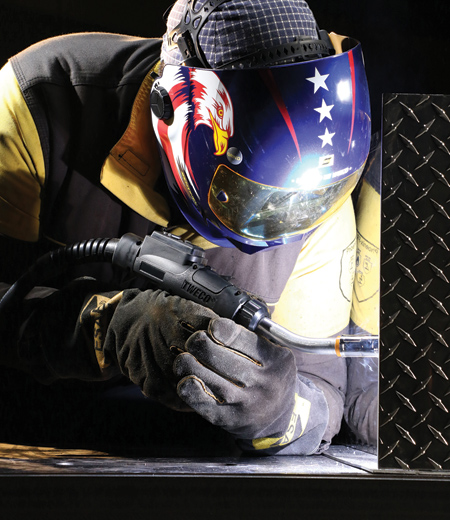
The Tweco PullMaster2 push-pull MIG gun increases operator comfort while increasing productivity in MIG aluminum applications.
To improve performance and productivity in MIG and pulsed MIG aluminum welding applications, or when feeding wire long distances and around obstacles, Tweco, an ESAB brand, has launched the PullMaster2 push-pull MIG gun.
The updated version of this pistol-grip style gun improves ergonomics through an angled cable-to-gun connection combined with a ball & socket strain relief that enhances balance and reduces perceived cable weight. The easy-to-grip handle features a short-stroke trigger for easier activation, while an aluminum unibody reduces parts for greater reliability, easier repair and weight reduction.
Because improper drive roll tension deforms soft aluminum wires and leads to feeding problems, the PullMaster2 now features an internal pre-set drive roll tension mechanism that reduces the risk of deforming the wire while providing positive feeding performance. The drive rolls are also electrically insulated to prevent microarcing, a common source of performance issues.
Available as an air-cooled model (with water-cooled models coming soon), the PullMaster2 feeds wire diameters from 0.030" to 0.052" (0.8 mm to 1.3 mm), has a rated duty cycle of 60% using mixed gas, is available with 20' or 33' cable length and uses standard Tweco 16APS contact tips. The PullMaster2 is available in standard and "smart" models.
"Smart MIG guns provide remote control at the gun so operators do not need to return to the feeder to adjust variables," said John Esposito, Global Product Manager, ESAB Welding & Cutting Products. "They eliminate a common source of downtime, reduce the potential for accidents by reducing trips to the feeder and promote better weld quality."
The PullMaster2 smart gun enables operators to select and switch between up to 10 synergic programs. A synergic program contains pre-programmed welding parameters that have been optimized for a particular wire, application or welding position. Using simple buttons and a digital display on the gun, operators can fine tune arc performance by increasing or decreasing voltage and wire feed speed, as well as select between 2T (standard) and 4T (latching) trigger mode to reduce hand fatigue on long welds.
The PullMaster2 smart model offers plug & play simplicity by automatically recognizing when it is connected to ESAB's new Robust Feed Pulse wire feeder paired with the new Aristo 500ix pulsing power source. The gun also works with the Aristo Feed 3004 feeder and Aristo 4004i power source.
"Coupled with our AlcoTec brand, ESAB now offers a full suite of advanced solutions for MIG and pulsed MIG welding of aluminum," noted Esposito. "This includes our recently introduced MXH 420W push-pull water-cooled MIG gun, which we designed as a replacement gun for older ESAB and competitive systems."
Push-pull welding systems maintain constant wire tension between two sets of drive rolls, one in the gun and one in the feeder, by synchronizing the drive roll motors. "The system can reliably feed soft aluminum wires or small diameter solid wires longer distances than is possible with conventional guns," said a company spokesperson. Push-pull systems also work well for applications that require draping the gun cable over an edge or around large obstacles, which is common when fabricating boats, trailers, buses, trucks, railcars, tanks and pressure vessels.
"Fabricators trying to use standard MIG guns with aluminum or feed long distances often experience problems related to inconsistent feeding," said Esposito. "These include the wire burning back to the contact tip, birds nesting at the drive rolls and slipping and causing incomplete fusion or spatter. Using push-pull guns like the PullMaster2 is a proven method of eliminating these problems and increasing productivity."
For more information contact:
ESAB Welding & Cutting Products
800-ESAB-123 / 864-466-0921
www.esabna.com